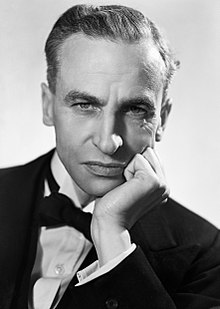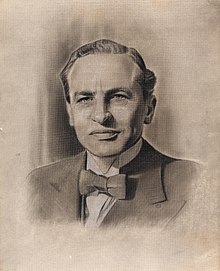Archibald Sinclair, 1st Viscount Thurso
The Viscount Thurso | |
|---|---|
 Archibald Sinclair as Secretary of State for Air during the Second World War | |
| Leader of the Liberal Party | |
| In office 26 November 1935 – 15 June 1945 | |
| Deputy | Percy Harris (1940–1945) |
| Preceded by | Sir Herbert Samuel |
| Succeeded by | Clement Davies |
| Secretary of State for Air | |
| In office 11 May 1940 – 23 May 1945 | |
| Monarch | George VI |
| Prime Minister | Winston Churchill |
| Preceded by | Sir Samuel Hoare, Bt |
| Succeeded by | Harold Macmillan |
| Deputy Leader of the Liberal Party | |
| In office 4 November 1931 – 26 November 1935 | |
| Leader | Herbert Samuel |
| Preceded by | Herbert Samuel |
| Succeeded by | Percy Harris 1940–1945 |
| Secretary of State for Scotland | |
| In office 25 August 1931 – 28 September 1932 | |
| Monarch | George V |
| Prime Minister | Ramsay MacDonald |
| Preceded by | William Adamson |
| Succeeded by | Sir Godfrey Collins |
| Liberal Chief Whip | |
| In office 1930 – 25 August 1931 | |
| Leader | David Lloyd George |
| Preceded by | Robert Hutchison |
| Succeeded by | Goronwy Owen |
| Member of Parliament for Caithness and Sutherland | |
| In office 15 November 1922 – 5 July 1945 | |
| Preceded by | Leicester Harmsworth |
| Succeeded by | Eric Gandar Dower |
| Personal details | |
| Born | Archibald Henry Macdonald Sinclair 22 October 1890 Chelsea, London, England |
| Died | 15 June 1970 (aged 79) |
| Political party | Liberal |
| Spouse | Marigold Forbes |
| Alma mater | Royal Military College, Sandhurst |
Archibald Henry Macdonald Sinclair, 1st Viscount Thurso, KT, CMG, PC (22 October 1890 – 15 June 1970), known as Sir Archibald Sinclair, Bt, between 1912 and 1952, and often as Archie Sinclair, was a British politician and leader of the Liberal Party.[1]
Background and education
Born in Chelsea, London,[2] Sinclair was the son of a Scottish father and an American mother. He was the great-great-grandson of Sir John Sinclair, 1st Baronet. In 1912, he succeeded his grandfather, Sir John Sinclair, 3rd Baronet, as fourth Baronet, of Ulbster. Educated at Eton College and the Royal Military College, Sandhurst, he was commissioned into the Life Guards in 1910.[3]
Military career
Sinclair served on the Western Front during the First World War[3] and rose to the rank of Major in the Guards Machine Gun Regiment. He served as second-in-command to Winston Churchill, when Churchill commanded the 6th Battalion of the Royal Scots Fusiliers in the Ploegsteert Wood sector of the Western Front in 1916, after Churchill had resigned as First Lord of the Admiralty. They formed a lasting friendship, which would become a significant political alliance in later decades. From 1919 to 1921, he served as Personal Military Secretary to Churchill, when he returned to the Cabinet as Secretary of State for War, then accompanied him to the Colonial Office as Private Secretary.[3]
Political career
In 1922, Sinclair entered the House of Commons as a Liberal Member of Parliament (MP) for Caithness and Sutherland,[4] supporting David Lloyd George and defeating the incumbent Liberal supporter of H. H. Asquith. His constituency was the largest, in terms of area, in the United Kingdom. He rose through the Liberal ranks as the party shrank in Parliament, becoming Chief Whip by 1930.[3]
In 1931, the Liberal Party joined the National Government of Ramsay MacDonald, with Sinclair appointed Secretary of State for Scotland.[5] He was sworn of the Privy Council at the same time.[6] In 1932, he, together with other Liberal ministers, resigned from the government in protest at the Ottawa Conference introducing a series of tariff agreements.
In the 1935 general election, Samuel lost his seat. Sinclair became the party's leader at the head of only 20 MPs. With the party now clearly marginalised as the third party on the fringe and few distinct domestic policies, with a parliamentary party that was primarily a collection of individuals elected as much for themselves as for their party, and with the separate Liberal Nationals offering competition amongst Liberal-inclined voters, Sinclair fought to make the Liberals once more a relevant force in British politics, taking up the issues of opposition to the continental dictatorships and working closely with Churchill, who was then unpopular and generally shunned by his Conservative Party.
When Churchill formed an all-party coalition government in 1940, Sinclair entered the cabinet as Secretary of State for Air. He did not sit in the small War Cabinet but was invited to attend meetings discussing any political matter. As Secretary for Air, his first task was to work with the RAF in planning the Battle of Britain. Towards the end of the war he found himself at odds with Churchill, arguing against Bomber Harris's strategy for the Bombing of Dresden.[7] He remained a minister until May 1945 when the coalition ended. In the 1945 general election, he narrowly lost his seat. His margin of defeat is one of the tightest on record; he came third: even though the victor had only 61 votes more than he.[3]
There was speculation that he might return to the Commons and the leadership, as the Conservative victor in his seat had promised to serve in parliament only until the end of war with Japan, a pledge he kept modifying to serving just one more year, every year. Sinclair awaited the imminent by-election, which never materialised. At the 1950 general election, Sinclair again stood for his old seat and moved to second place, but in yet another close election, he remained 269 votes away from victory.[citation needed] In 1952, the year of his first stroke, he accepted elevation to the House of Lords as Viscount Thurso, of Ulbster in the County of Caithness.[8] He was expected to take up the leadership of the Liberal group in the House of Lords, but a much more serious stroke in 1959 left him largely bedridden and in a state of precarious health until his death, in 1970.[9]
Family

In 1918 Sinclair married Marigold (1897-1975), daughter of Lieutenant-Colonel James Stewart Forbes and Lady Angela Forbes. They had four children: the Hon. Catherine (1919-2007), the Hon. Elizabeth (1921-1994), Robin (1922–1995), and the Hon. Angus (born 1925).[10] Sinclair was one of the largest landowners in the United Kingdom, owning an estate of about 100,000 ac (40,000 ha) in Caithness. He was handsome and charming and regarded[by whom?] as a daredevil, but in private life he was rather shy, reserved and antisocial, with a slight speech impediment.[citation needed]
In the 1990s, his grandson, John Sinclair, entered politics and sat from 2001 to 2015 as the Liberal Democrat MP for his grandfather's seat, Caithness, Sutherland and Easter Ross. Sinclair's granddaughter, Veronica Linklater, Baroness Linklater of Butterstone (daughter of the Hon. Elizabeth Sinclair), has also become a Liberal Democrat politician.[10]
Styles of address
- 1890-1912: Mr Archibald Sinclair
- 1912-1922: Sir Archibald Sinclair Bt
- 1922: Sir Archibald Sinclair Bt CMG
- 1922-1931: Sir Archibald Sinclair Bt CMG MP
- 1931-1941: The Rt Hon. Sir Archibald Sinclair Bt CMG MP
- 1941-1945: The Rt Hon. Sir Archibald Sinclair Bt KT CMG MP
- 1945-1952: The Rt Hon. Sir Archibald Sinclair Bt KT CMG
- 1952-1970: The Rt Hon. The Viscount Thurso KT CMG PC[a]
Recognition
Because he had been Secretary of State for Air during the Battle of Britain, the Southern Railway named a Battle of Britain Class Light Pacific steam locomotive "Sir Archibald Sinclair". See SR West Country and Battle of Britain classes The ceremonial naming of the locomotive was performed by Sir Archibald himself at Waterloo station on 24 February 1948. The SR number of the locomotive was 21C159 and its British Railways number was 34059. By chance, in 1966 when the locomotive was no longer needed by BR, it was purchased for scrap by Woodham Brothers of Barry. Thus for years it was available for purchase by a preservation society, which was eventually done by the Bluebell Railway who restored it to working order. As of 2015 the last time the locomotive had run was 2011 when serious damage to the firebox was discovered.
References
- ^ Full coverage of his career appears in Gerard DeGroot, Liberal Crusader: The Life of Sir Archibald Sinclair (New York University Press, 1993).
- ^ Wikitree Archibald Sinclair
- ^ a b c d e Oxford Dictionary of National Biography - subscription based; accessed 26 July 2011
- ^ "No. 32775". The London Gazette. 8 December 1922. p. 8712.
- ^ "No. 33748". The London Gazette. 28 August 1931. p. 5616.
- ^ "No. 33748". The London Gazette. 28 August 1931. p. 5615.
- ^ Liberal Crusader by Gerard de Groot
- ^ "No. 39516". The London Gazette. 15 April 1952. p. 2077.
- ^ "John Thurso: The hereditary peer who became an MP". BBC News. 22 February 2011. Retrieved 2 August 2011.
- ^ a b thepeerage.com Archibald Henry Macdonald Sinclair, 1st Viscount Thurso
Bibliography
- Violet Bonham Carter, ed. Mark Pottle, Champion Redoubtable: The Diaries of Violet Bonham Carter 1914-1945 (Weidenfeld & Nicolson, 1998)
- Gerard DeGroot, Liberal Crusader: The Life of Sir Archibald Sinclair (New York University Press, 1993)
- ed. Ian Hunter, Winston and Archie: The collected correspondence of Winston Churchill and Sir Archibald Sinclair (Politico's, 2005)
- Torrance, David, The Scottish Secretaries (Birlinn 2006)
External links
- Hansard 1803–2005: contributions in Parliament by the Viscount Thurso
- Sir Archibald Sinclair (Viscount Thurso) 1890-1970 biography from the Liberal Democrat History Group
- Newspaper clippings about Archibald Sinclair, 1st Viscount Thurso in the 20th Century Press Archives of the ZBW
- Use dmy dates from April 2012
- 1890 births
- 1970 deaths
- People educated at Eton College
- Scottish Liberal Party MPs
- Lord-Lieutenants of Caithness
- Members of the Parliament of the United Kingdom for Highland constituencies
- British Life Guards officers
- Companions of the Order of St Michael and St George
- Graduates of the Royal Military College, Sandhurst
- Knights of the Thistle
- Leaders of the Liberal Party (UK)
- Members of the Privy Council of the United Kingdom
- Secretaries of State for Scotland
- Secretaries of State for Air (UK)
- Viscounts in the Peerage of the United Kingdom
- British Army personnel of World War I
- Rectors of the University of Glasgow
- UK MPs 1922–23
- UK MPs 1923–24
- UK MPs 1924–29
- UK MPs 1929–31
- UK MPs 1931–35
- UK MPs 1935–45
- Royal Scots Fusiliers officers

